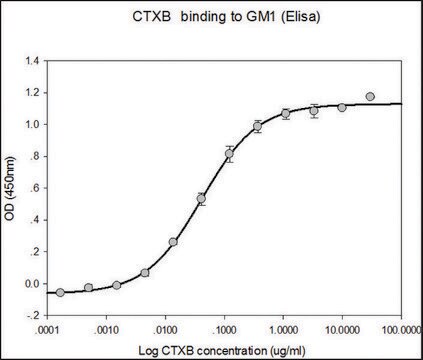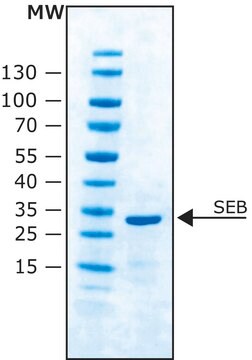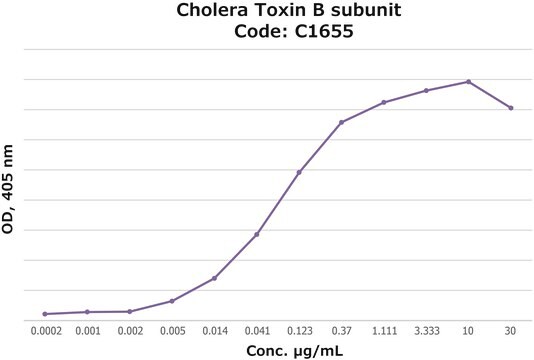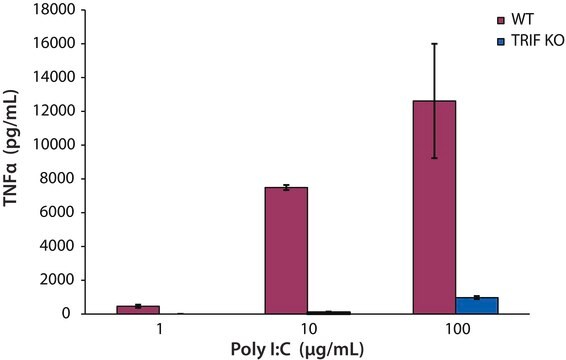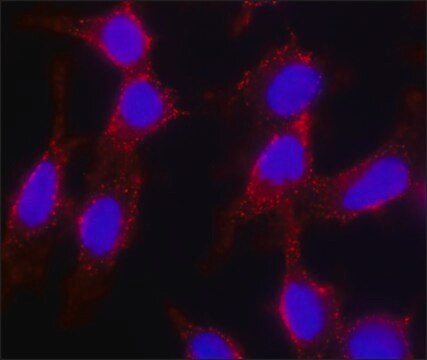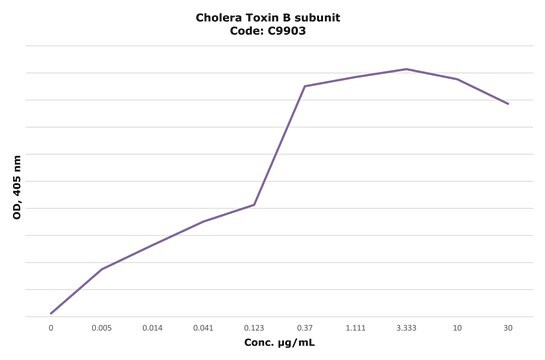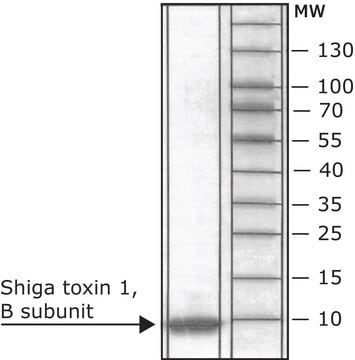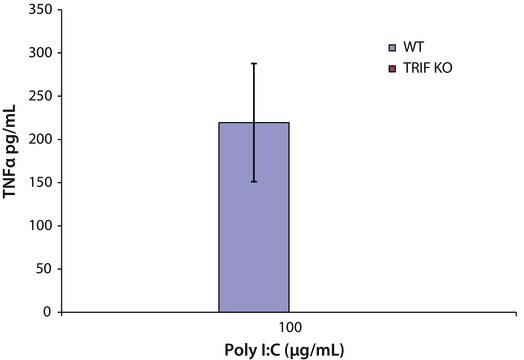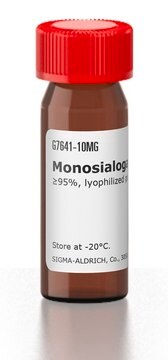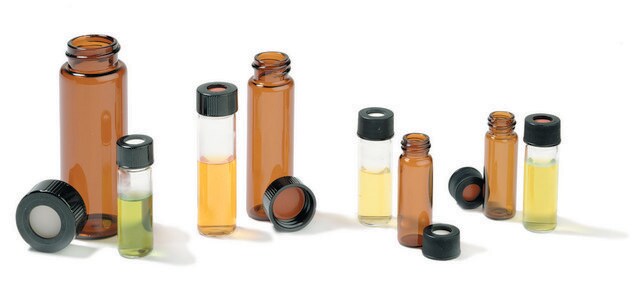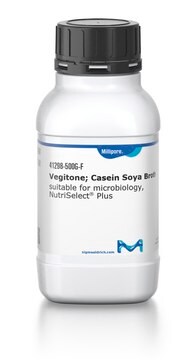E8656
Heat-Labile Enterotoxin, B subunit from E. coli
recombinant, expressed in Pichia pastoris, >90% (SDS-PAGE), lyophilized powder
Sinónimos:
LTB
Iniciar sesiónpara Ver la Fijación de precios por contrato y de la organización
About This Item
Código UNSPSC:
12352200
NACRES:
NA.77
Productos recomendados
recombinante
expressed in Pichia pastoris
Nivel de calidad
Análisis
>90% (SDS-PAGE)
formulario
lyophilized powder
Condiciones de envío
wet ice
temp. de almacenamiento
2-8°C
Aplicación
Heat-Labile Enterotoxin, B subunit (LTB) from E. coli has been used in enzyme-linked immunosorbent assay (ELISA).
Acciones bioquímicas o fisiológicas
Enterotoxigenic Escherichia coli causes diarrhea through its heat-labile enterotoxin (LT). The LT is a periplasmic protein composed of one A subunit (LTA, 27 kDa) and five non-covalently associated B subunits (LTB, 11.6 kDa each) forming a ring-like pentamer. LTB has high affinity towards the toxin receptor ganglioside GM1, a glycosphingolipid found ubiquitously on the surface of mammalian cells. Ganglioside GM1 facilitates the delivery of the A subunit to the cytosol of the target cell resulting in persistent synthesis of cAMP and subsequently diarrhea. This characteristic makes LTB a good label for microglial cells (due to the enrichment of ganglioside GM1 on their cell surface). In addition, studies made mostly with animal models demonstrated that recombinant LTB could stimulate strong serum and mucosal immune responses against LT. Other studies have indicated that LTB could be used as a potent mucosal adjuvant.
Características y beneficios
This compound is a featured product for Cyclic Nucleotide research. Click here to discover more featured Cyclic Nucleotide products. Learn more about bioactive small molecules for other areas of research at sigma.com/discover-bsm.
Forma física
Lyophilized from a solution containing Heat-Labile Enterotoxin, B subunit in 0.05 M Tris buffer, pH 7.5, 0.2 M NaCl, 3 mM NaN3, and 1 mM sodium EDTA.
Nota de análisis
The activity is measured by ELISA using ganglioside GM1-coated plates (Cat. No. G7641). LTB at various concentrations is incubated on the ganglioside GM1 coated wells, followed by anti-cholera toxin antibody (Cat. No. C3062), and peroxidase-labeled goat anti-rabbit IgG (Cat.No. A0545) as the secondary antibody. Binding saturation of 50% may be achieved with = 0.12 μg/mL of LTB.
Palabra de señalización
Warning
Frases de peligro
Consejos de prudencia
Clasificaciones de peligro
Acute Tox. 4 Dermal - Aquatic Chronic 3
Código de clase de almacenamiento
11 - Combustible Solids
Clase de riesgo para el agua (WGK)
WGK 1
Punto de inflamabilidad (°F)
Not applicable
Punto de inflamabilidad (°C)
Not applicable
Equipo de protección personal
Eyeshields, Faceshields, Gloves, type ABEK (EN14387) respirator filter
Certificados de análisis (COA)
Busque Certificados de análisis (COA) introduciendo el número de lote del producto. Los números de lote se encuentran en la etiqueta del producto después de las palabras «Lot» o «Batch»
¿Ya tiene este producto?
Encuentre la documentación para los productos que ha comprado recientemente en la Biblioteca de documentos.
Los clientes también vieron
Safety and immunogenicity of escalating dosages of a single oral administration of peru-15 pCTB, a candidate live, attenuated vaccine against enterotoxigenic Escherichia coli and Vibrio cholerae
Chen WH, et al.
Clinical and Vaccine Immunology : CVI, 22(1) (2015)
Preformulation Characterization and Stability Assessments of Secretory IgA Monoclonal Antibodies as Potential Candidates for Passive Immunization by Oral Administration
Hu Y, et al.
Journal of Pharmaceutical Sciences, 109(1) (2020)
Sandra Scheiblhofer et al.
Vaccine, 39(32), 4399-4403 (2021-07-07)
The skin represents an attractive target tissue for vaccination against respiratory viruses such as SARS-CoV-2. Laser-facilitated epicutaneous immunization (EPI) has been established as a novel technology to overcome the skin barrier, which combines efficient delivery via micropores with an inherent
Plastid expression of a double-pentameric vaccine candidate containing human papillomavirus-16 L1 antigen fused with LTB as adjuvant: transplastomic plants show pleiotropic phenotypes
Waheed MT, et al.
Plant Biotechnology Journal, 9(6) (2011)
Nuestro equipo de científicos tiene experiencia en todas las áreas de investigación: Ciencias de la vida, Ciencia de los materiales, Síntesis química, Cromatografía, Analítica y muchas otras.
Póngase en contacto con el Servicio técnico